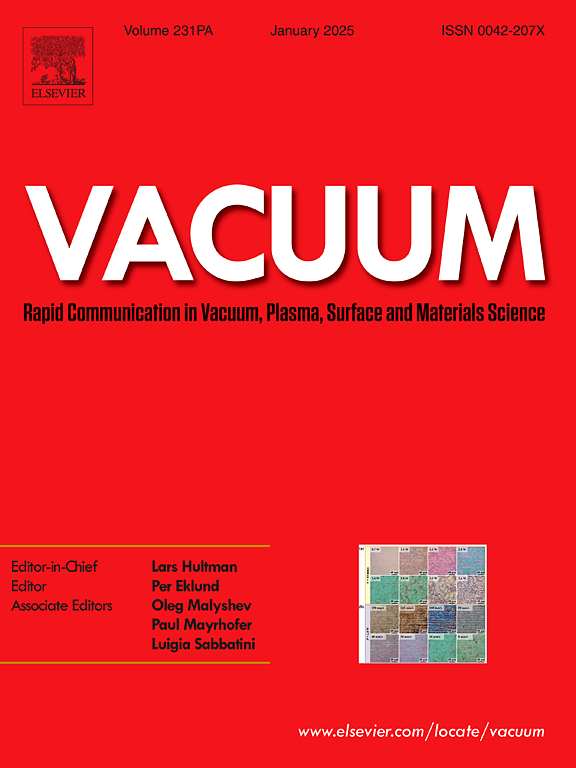Investigation of microstructure, mechanical properties, and high-temperature self-lubrication capacities of CaF2/BaF2 reinforced CoCrFeNiV matrix composites
IF 3.9
2区 材料科学
Q2 MATERIALS SCIENCE, MULTIDISCIPLINARY
引用次数: 0
Abstract
Due to the rapid degradation of traditional liquid lubricants under extreme service conditions, solid self-lubricating composites have emerged as promising candidates in engineering fields, owing to their ability to operate effectively at temperatures above 400 °C. In this work, a series of high-performance CoCrFeNiV-CaF2/BaF2 solid-lubricating composites were synthesized by vacuum heating-press sintering techniques. The composites showed high hardness of 582.8 ± 8 HV, attributed to the presence of the σ-phase. Tribological tests showed that the BaF2/CaF2 solid lubricant, along with oxide glazing layer on the sliding surface, significantly reduced friction and wear at 600 °C. At 800 °C, the V2O5 in the glazing layer enhanced lubrication, lowering the friction coefficient further. However, its brittle rod-like structure led to higher wear rates. These results indicate that CoCrFeNiV-CaF2/BaF2 self-lubricating composites are excellent wear-resistant materials at medium temperatures.
CaF2/BaF2增强CoCrFeNiV基复合材料显微组织、力学性能及高温自润滑性能研究
由于传统的液体润滑剂在极端使用条件下会迅速降解,固体自润滑复合材料由于能够在400°C以上的温度下有效工作而成为工程领域的有前途的候选者。本文采用真空加热-压制烧结技术合成了一系列高性能CoCrFeNiV-CaF2/BaF2固体润滑复合材料。复合材料的硬度为582.8±8hv,主要归因于σ相的存在。摩擦学试验表明,BaF2/CaF2固体润滑剂以及滑动表面的氧化釉层显著降低了600℃下的摩擦磨损。在800℃时,上釉层中的V2O5增强了润滑,进一步降低了摩擦系数。然而,其脆杆状结构导致较高的磨损率。这些结果表明,CoCrFeNiV-CaF2/BaF2自润滑复合材料是一种优异的中温耐磨材料。
本文章由计算机程序翻译,如有差异,请以英文原文为准。
求助全文
约1分钟内获得全文
求助全文
来源期刊

Vacuum
工程技术-材料科学:综合
CiteScore
6.80
自引率
17.50%
发文量
0
审稿时长
34 days
期刊介绍:
Vacuum is an international rapid publications journal with a focus on short communication. All papers are peer-reviewed, with the review process for short communication geared towards very fast turnaround times. The journal also published full research papers, thematic issues and selected papers from leading conferences.
A report in Vacuum should represent a major advance in an area that involves a controlled environment at pressures of one atmosphere or below.
The scope of the journal includes:
1. Vacuum; original developments in vacuum pumping and instrumentation, vacuum measurement, vacuum gas dynamics, gas-surface interactions, surface treatment for UHV applications and low outgassing, vacuum melting, sintering, and vacuum metrology. Technology and solutions for large-scale facilities (e.g., particle accelerators and fusion devices). New instrumentation ( e.g., detectors and electron microscopes).
2. Plasma science; advances in PVD, CVD, plasma-assisted CVD, ion sources, deposition processes and analysis.
3. Surface science; surface engineering, surface chemistry, surface analysis, crystal growth, ion-surface interactions and etching, nanometer-scale processing, surface modification.
4. Materials science; novel functional or structural materials. Metals, ceramics, and polymers. Experiments, simulations, and modelling for understanding structure-property relationships. Thin films and coatings. Nanostructures and ion implantation.
 求助内容:
求助内容: 应助结果提醒方式:
应助结果提醒方式:


